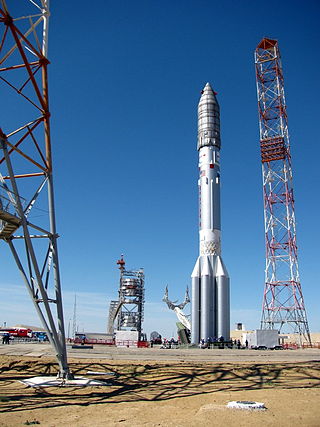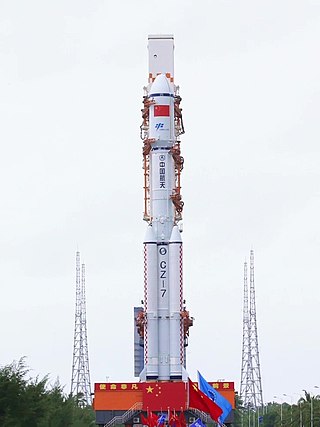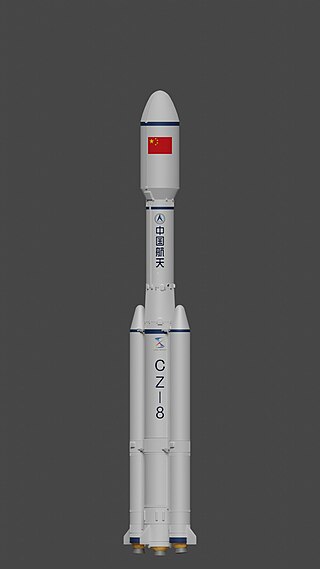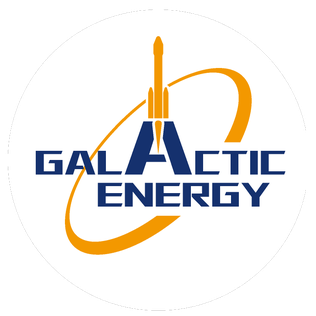Related Research Articles

An expendable launch system is a launch vehicle that can be launched only once, after which its components are destroyed during reentry or impact with Earth, or discarded in space. ELVs typically consist of several rocket stages that are discarded sequentially as their fuel is exhausted and the vehicle gains altitude and speed. As of 2024, fewer and fewer satellites and human spacecraft are launched on ELVs in favor of reusable launch vehicles. However, there are many instances where a ELV may still have a compelling use case over a reusable vehicle. ELVs are simpler in design than reusable launch systems and therefore may have a lower production cost. Furthermore, an ELV can use its entire fuel supply to accelerate its payload, offering greater payloads. ELVs are proven technology in widespread use for many decades.

The Polar Satellite Launch Vehicle (PSLV) is an expendable medium-lift launch vehicle designed and operated by the Indian Space Research Organisation (ISRO). It was developed to allow India to launch its Indian Remote Sensing (IRS) satellites into Sun-synchronous orbits, a service that was, until the advent of the PSLV in 1993, only commercially available from Russia. PSLV can also launch small size satellites into Geostationary Transfer Orbit (GTO).

The Angara rocket family is a family of launch vehicles being developed by the Moscow-based Khrunichev State Research and Production Space Center. The launch vehicles are to put between 3,800 kg (8,400 lb) and 24,500 kg (54,000 lb) into low Earth orbit and are intended, along with Soyuz-2 variants, to replace several existing launch vehicles.

Geosynchronous Satellite Launch Vehicle (GSLV) is a class of expendable launch systems operated by the Indian Space Research Organisation (ISRO). GSLV has been used in fifteen launches since 2001.
The highest specific impulse chemical rockets use liquid propellants. They can consist of a single chemical or a mix of two chemicals, called bipropellants. Bipropellants can further be divided into two categories; hypergolic propellants, which ignite when the fuel and oxidizer make contact, and non-hypergolic propellants which require an ignition source.

The Proton-M, (Протон-М) GRAU index 8K82M or 8K82KM, is an expendable Russian heavy-lift launch vehicle derived from the Soviet-developed Proton. It is built by Khrunichev, and launched from sites 81/24 and 200/39 at the Baikonur Cosmodrome in Kazakhstan. Commercial launches are marketed by International Launch Services (ILS), and generally use Site 200/39. The first Proton-M launch occurred on 7 April 2001.

Antares, known during early development as Taurus II, is an American expendable medium-lift launch vehicle developed and built by Orbital Sciences Corporation with financial support from NASA under the Commercial Orbital Transportation Services (COTS) program awarded in February 2008, alongside the company's automated cargo spacecraft, Cygnus. Like other launch vehicles developed by Orbital, Antares leveraged lower-cost, off-the-shelf parts and designs.

The Safir was the first Iranian expendable launch vehicle able to place a satellite in orbit. The first successful orbital launch using the Safir launch system took place on 2 February 2009 when a Safir carrier rocket placed the Omid satellite into an orbit with a 245.2 km (152.4 mi) apogee. This made Iran the ninth nation capable of producing and launching a satellite.

The RD-191 is a high-performance single-combustion chamber rocket engine, developed in Russia and sold by Roscosmos. It is derived from the RD-180 dual-combustion chamber engine, which itself was derived in turn from the four-chamber RD-170 originally used in the Energia launcher.

The Long March 7, or Chang Zheng 7 in pinyin, abbreviated LM-7 for export or CZ-7 within China, originally Long March 2F/H or Chang Zheng 2F/H, nicknamed Bingjian, is a Chinese liquid-fuelled launch vehicle of the Long March family, developed by the China Aerospace Science and Technology Corporation (CAST). It made its inaugural flight on 25 June 2016.
A heavy-lift launch vehicle (HLV) is an orbital launch vehicle capable of lifting payloads between 20,000 to 50,000 kg or between 20,000 to 100,000 kilograms into low Earth orbit (LEO). Heavy-lift launch vehicles often carry payloads into higher-energy orbits, such as geosynchronous transfer orbit (GTO) or heliocentric orbit (HCO). An HLV is between a medium-lift launch vehicle and a super heavy-lift launch vehicle.

Long March 8 is an orbital launch vehicle developed by the China Academy of Launch Vehicle Technology to launch up to 5000 kg to a 700 km altitude Sun-synchronous orbit (SSO). The rocket is based on the Long March 7 with its first stage and two boosters, along with the existing liquid hydrogen burning third stage of the Long March 3A/3B/3C and 7A as its second stage. The boosters are omitted in the "core only" variant that first flew on its second launch in February 2022.

Falcon 9 Full Thrust is a partially reusable, two-stage-to-orbit, medium-lift launch vehicle designed and manufactured in the United States by SpaceX. It is the third major version of the Falcon 9 family, designed starting in 2014, with its first launch operations in December 2015. It was later refined into the Block 4 and Block 5. As of 17 December 2024, all variants of the Falcon 9 Full Thrust had performed 394 launches with only one failure: Starlink Group 9-3.
LandSpace Technology Corporation is a Chinese commercial space launch provider based in Beijing. It was founded in 2015 by Zhang Changwu.

Zhuque-2 is a Chinese medium-class orbital launch vehicle developed by LandSpace. It is a liquid-fuelled rocket powered by liquid oxygen and liquid methane (methalox) and was the first methane-fueled rocket to reach orbit.

Spaceflight in 2025 promises to follow the 2020s trend of record breaking orbital launches and increased developments in lunar, Mars and low-earth orbit exploration.

The TQ-12 is a gas-generator cycle rocket engine burning liquid methane and liquid oxygen (methalox) developed by LandSpace. TQ-12 is the first Chinese liquid rocket engine developed with private funding. The engine has been designed to produce 670 kilonewtons (150,000 lbf) of thrust at sea level.

Galactic Energy is a Chinese private space launch enterprise flying the Ceres-1 and developing the Pallas-1 orbital rockets. The company's long-term objective is to mine asteroids for rare metals and minerals.
The TQ-11 is a gas-generator cycle rocket engine burning liquid methane and liquid oxygen developed by LandSpace. It is used as the second stage vernier engine for LandSpace's ZQ-2 rocket. The engine produces 80 kilonewtons (18,000 lbf) of thrust in a vacuum.

Space Pioneer, also known as Beijing Tianbing Technology Co., Ltd., is a Chinese aerospace company developing reusable orbital rocket technology—both launch vehicles and liquid rocket engines—to access the market for low-cost space launch services. The company is aiming to meet launch requirements for both the Chinese national satellite internet project and also the CNSA solicitation for resupply of the Tiangong space station.
References
- ↑ Beil, Adrian (9 October 2022). "China launches Advanced Space-borne Solar Observatory". NASASpaceFlight.com. Retrieved 23 November 2022.
- ↑ Zafar, Ramish (20 October 2022). "China's Largest Private Rocket Engine Breathes Fire In First Successful Test". Wccftech. Retrieved 23 November 2022.
- ↑ "蓝箭航天首台天鹊A发动机成功交付". Weixin Official Accounts Platform (in Chinese (China)). Retrieved 15 March 2024.
- ↑ Jones, Andrew (27 November 2024). "Landspace puts 2 satellites in orbit with enhanced Zhuque-2 rocket". SpaceNews. Retrieved 27 November 2024.
